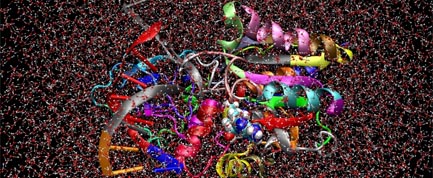Chemists Concoct Part of Life's Recipe

For decades, scientists have argued about and pondered over whether biology began on our planet or arrived from above. If it started here, it presumably took millions of years for Earth to cook up life's essential molecules from scratch.
Now a team of chemists has computed a possible real-world recipe for one of these biomolecules, in research that suggests life started in a local pond rather than raining down from space.
Living cells are like tiny chemical factories, assembling long molecular chains such as DNA and proteins. But prior to life's emergence on Earth, these complex molecules must have come together by themselves, without the help of living cells.
"Just where these biomolecules originated isn’t known," said Paul von Rague Schleyer from the University of Georgia. "They could have formed from smaller molecules present on primitive Earth, either very slowly over millions of years or rapidly before the Earth cooled down."
A number of biomolecule ingredients have been detected in space and in meteorites. Recently some researchers postulated that adenine—one of the four nucleic bases of DNA—formed in interstellar clouds and later rained down on Earth, reminiscent of an earlier comet-seeding idea.
Adenine is abundant on our planet and has even been found in meteorites. It is vital to life as part of the four-letter alphabet that encodes genetic information.
In 1960, scientists showed that a small fraction of adenine could be made from a mixture of poisonous hydrogen cyanide (HCN) and ammonia. Over the years, other researchers have made adenine from HCN, but the exact mechanism has never been explained.
Get the world’s most fascinating discoveries delivered straight to your inbox.
Now Schleyer and his colleagues have theoretically calculated all of the intricate reaction steps that transform simple HCN molecules into adenine, as described in the Oct. 30 issue of the journal Proceedings of the National Academy of Sciences.
Their model does not pinpoint where this adenine formation could have occurred, but the reactions are unlikely to proceed outside of a liquid solution, which may argue against a purely space-based origin. The authors are aware, however, that much work remains to explain how the other pieces of DNA came to be.
"Our investigation should trigger similar investigations of the abiotic formation of the remaining nucleic acid bases as well as other biologically relevant molecules,” the authors wrote.
- Top 10 Intelligent Design (or Creation Myths)
- Darwin Gallery: Darwin on Display
- Greatest Mysteries: How Did Life Arise on Earth?



